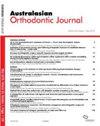The applicability of the Tanaka and Johnston analysis in a contemporary Western Australian population
IF 0.9
4区 医学
Q4 DENTISTRY, ORAL SURGERY & MEDICINE
引用次数: 0
Abstract
Abstract Background/Objective The Tanaka and Johnston mixed dentition analysis is a widely used method to predict the size of unerupted permanent canines and premolars. The aim of the present study was to determine the applicability of the Tanaka and Johnston analysis to Western Australian adolescents and develop a new regression equation. Methods Five hundred participants (323 females, 177 males) meeting the inclusion criteria were selected from private orthodontic clinics. The mesiodistal dimensions of all permanent teeth were retrieved from pre-orthodontic treatment digital dental records using Invisalign® technology (Invisalign®, Align Technology, Santa Clara, CA, USA) and analysed using a predicted value derived from the Tanaka and Johnston analysis. Correlation and linear regression analyses were applied to develop new regression equations. Result A significant difference was found between the actual and predicted values derived from the Tanaka and Johnston analysis. A significant correlation was observed between the sum of the permanent mandibular incisors and the sum of the maxillary and mandibular canine and premolars (0.58–0.74). New regression equations and tables were derived from the study population. Conclusion The Tanaka and Johnston analysis overestimated the mesiodistal dimensions of permanent canines and premolars. The developed regression equation and tables may be used for orthodontic diagnosis and treatment planning in Western Australian adolescents.Tanaka和Johnston分析在当代西澳大利亚人口中的适用性
背景/目的Tanaka和Johnston混合牙列分析是一种广泛应用于预测未出牙恒牙和前磨牙大小的方法。本研究的目的是确定Tanaka和Johnston分析对西澳大利亚青少年的适用性,并建立一个新的回归方程。方法选取符合入选标准的私立正畸门诊患者500人,其中女性323人,男性177人。使用Invisalign®技术(Invisalign®,Align technology, Santa Clara, CA, USA)从正畸治疗前的数字牙科记录中检索所有恒牙的中远端尺寸,并使用Tanaka和Johnston分析得出的预测值进行分析。运用相关分析和线性回归分析建立了新的回归方程。结果Tanaka和Johnston分析得出的实际值与预测值之间存在显著差异。下颌恒切牙总数与上颌、下颌犬齿和前磨牙总数有显著相关(0.58 ~ 0.74)。从研究人群中导出了新的回归方程和表。结论Tanaka和Johnston的分析高估了恒牙和前磨牙的中远端尺寸。所建立的回归方程和回归表可用于西澳大利亚州青少年正畸诊断和治疗计划。
本文章由计算机程序翻译,如有差异,请以英文原文为准。
求助全文
约1分钟内获得全文
求助全文
来源期刊

Australasian Orthodontic Journal
Dentistry-Orthodontics
CiteScore
0.80
自引率
25.00%
发文量
24
期刊介绍:
The Australasian Orthodontic Journal (AOJ) is the official scientific publication of the Australian Society of Orthodontists.
Previously titled the Australian Orthodontic Journal, the name of the publication was changed in 2017 to provide the region with additional representation because of a substantial increase in the number of submitted overseas'' manuscripts. The volume and issue numbers continue in sequence and only the ISSN numbers have been updated.
The AOJ publishes original research papers, clinical reports, book reviews, abstracts from other journals, and other material which is of interest to orthodontists and is in the interest of their continuing education. It is published twice a year in November and May.
The AOJ is indexed and abstracted by Science Citation Index Expanded (SciSearch) and Journal Citation Reports/Science Edition.
 求助内容:
求助内容: 应助结果提醒方式:
应助结果提醒方式:


